Discharge profiles across the sleep-waking cycle of identified cholinergic, GABAergic, and glutamatergic neurons in the pontomesencephalic tegmentum of the rat
- PMID: 24672016
- PMCID: PMC3965793
- DOI: 10.1523/JNEUROSCI.2617-13.2014
Discharge profiles across the sleep-waking cycle of identified cholinergic, GABAergic, and glutamatergic neurons in the pontomesencephalic tegmentum of the rat
Abstract
Distributed within the laterodorsal tegmental and pedunculopontine tegmental nuclei (LDT and PPT), cholinergic neurons in the pontomesencephalic tegmentum have long been thought to play a critical role in stimulating cortical activation during waking (W) and paradoxical sleep (PS, also called REM sleep), yet also in promoting PS with muscle atonia. However, the discharge profile and thus precise roles of the cholinergic neurons have remained uncertain because they lie intermingled with GABAergic and glutamatergic neurons, which might also assume these roles. By applying juxtacellular recording and labeling in naturally sleeping-waking, head-fixed rats, we investigated the discharge profiles of histochemically identified cholinergic, GABAergic, and glutamatergic neurons in the LDT, SubLDT, and adjoining medial part of the PPT (MPPT) in relation to sleep-wake states, cortical activity, and muscle tone. We found that all cholinergic neurons were maximally active during W and PS in positive correlation with fast (γ) cortical activity, as "W/PS-max active neurons." Like cholinergic neurons, many GABAergic and glutamatergic neurons were also "W/PS-max active." Other GABAergic and glutamatergic neurons were "PS-max active," being minimally active during W and maximally active during PS in negative correlation with muscle tone. Conversely, some glutamatergic neurons were "W-max active," being maximally active during W and minimally active during PS in positive correlation with muscle tone. Through different discharge profiles, the cholinergic, GABAergic, and glutamatergic neurons of the LDT, SubLDT, and MPPT thus appear to play distinct roles in promoting W and PS with cortical activation, PS with muscle atonia, or W with muscle tone.
Keywords: EEG; EMG; REM sleep; paradoxical sleep; slow-wave sleep.
Figures
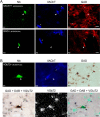
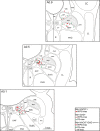
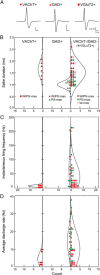
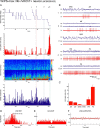
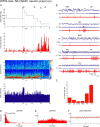

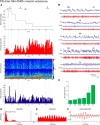
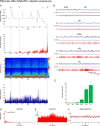
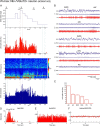


Similar articles
-
Discharge profiles of identified GABAergic in comparison to cholinergic and putative glutamatergic basal forebrain neurons across the sleep-wake cycle.J Neurosci. 2009 Sep 23;29(38):11828-40. doi: 10.1523/JNEUROSCI.1259-09.2009. J Neurosci. 2009. PMID: 19776269 Free PMC article.
-
Activity profiles of cholinergic and intermingled GABAergic and putative glutamatergic neurons in the pontomesencephalic tegmentum of urethane-anesthetized rats.J Neurosci. 2009 Apr 8;29(14):4664-74. doi: 10.1523/JNEUROSCI.5502-08.2009. J Neurosci. 2009. PMID: 19357291 Free PMC article.
-
Discharge properties of presumed cholinergic and noncholinergic laterodorsal tegmental neurons related to cortical activation in non-anesthetized mice.Neuroscience. 2012 Nov 8;224:172-90. doi: 10.1016/j.neuroscience.2012.08.032. Epub 2012 Aug 21. Neuroscience. 2012. PMID: 22917614
-
Paradoxical sleep and its chemical/structural substrates in the brain.Neuroscience. 1991;40(3):637-56. doi: 10.1016/0306-4522(91)90002-6. Neuroscience. 1991. PMID: 2062436 Review.
-
Principal cell types of sleep-wake regulatory circuits.Curr Opin Neurobiol. 2017 Jun;44:101-109. doi: 10.1016/j.conb.2017.03.018. Epub 2017 Apr 19. Curr Opin Neurobiol. 2017. PMID: 28433001 Free PMC article. Review.
Cited by
-
Optogenetic activation of cholinergic neurons in the PPT or LDT induces REM sleep.Proc Natl Acad Sci U S A. 2015 Jan 13;112(2):584-9. doi: 10.1073/pnas.1423136112. Epub 2014 Dec 29. Proc Natl Acad Sci U S A. 2015. PMID: 25548191 Free PMC article.
-
Active control of arousal by a locus coeruleus GABAergic circuit.Nat Neurosci. 2019 Feb;22(2):218-228. doi: 10.1038/s41593-018-0305-z. Epub 2019 Jan 14. Nat Neurosci. 2019. PMID: 30643295 Free PMC article.
-
Response to "Concerns regarding Baksa et al., Cell Molec. Life Sci., 2019." by Edgar Garcia-Rill and Francisco J. Urbano (CMLS-D-18-0156R1).Cell Mol Life Sci. 2019 Dec;76(23):4583-4587. doi: 10.1007/s00018-019-03308-w. Epub 2019 Nov 6. Cell Mol Life Sci. 2019. PMID: 31691836 Free PMC article. No abstract available.
-
Multiple Sources of Cholinergic Input to the Superior Olivary Complex.Front Neural Circuits. 2021 Jul 15;15:715369. doi: 10.3389/fncir.2021.715369. eCollection 2021. Front Neural Circuits. 2021. PMID: 34335196 Free PMC article.
-
Homeostatic regulation through GABA and acetylcholine muscarinic receptors of motor trigeminal neurons following sleep deprivation.Brain Struct Funct. 2017 Sep;222(7):3163-3178. doi: 10.1007/s00429-017-1392-4. Epub 2017 Mar 15. Brain Struct Funct. 2017. PMID: 28299422 Free PMC article.
References
Publication types
MeSH terms
Substances
Grants and funding
LinkOut - more resources
Full Text Sources
Other Literature Sources
